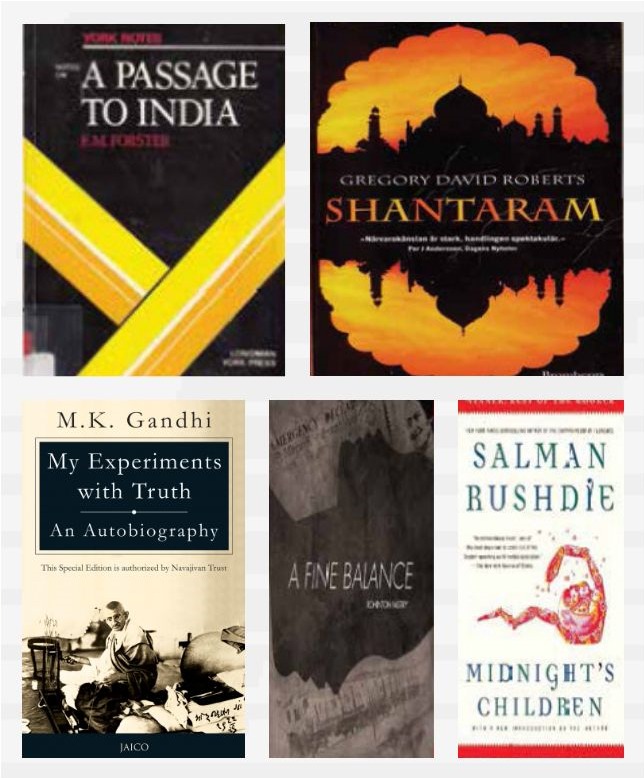Welcome to India
Indian National Anthem
Jana-gana-mana-adhinayaka, jaya he
Bharata-bhagya-vidhata.
Punjab-Sindh-Gujarat-Maratha
Dravida-Utkala-Banga
Vindhya-Himachala-Yamuna-Ganga
Uchchala-Jaladhi-taranga.
Tava shubha name jage,
Tava shubha asisa mage,
Gahe tava jaya gatha,
Jana-gana-mangala-dayaka jaya he
Bharata-bhagya-vidhata.
Jaya he, jaya he, jaya he, Jaya jaya jaya, jaya he!
Our National Anthem, composed originally in Bangla by Rabindranath Tagore, was adopted in its Hindi version by the Constituent Assembly as the national anthem of India on 24th January 1950.
BIBLIOGRAPHY
- A Passage to India by E.M. Forster
- The Argumentative India by Amartya Sen
- My Experiments with Truth by M.K. Gandhi
- A Fine Balance by Rohinton Mistry
- Midnight’s Children by Salman Rushdie
- Woven Wonder: The Tradition of Indian Textiles by Asharani Mathur
- Dictionary of Indian Mythology by Narendra Nath Bhattacharya
- The Discovery of India by Jawaharlal Nehru
INDIA ME AAPKA SWAGAT HAI (WELCOME TO INDIA)

India at a glance:
- President: Smt. Droupadi Murmu
- Prime Minister: Shri Narendra Modi
- Government: Federal Public
- Capital: New Delhi
- Area: 3.1 million sq. km
- 29 States and 7 Union Territories
- Currency: Indian Rupee ₹
- Population: 1.3 billion
- GDP (PPP): 3rd largest economy; $9.4 trillion (2017-18)
- Literacy rate: 74% (2011 Census)
- Major languages: Hindi, English and more than 20 other official languages
- Major religions: Hinduism, Islam, Christianity, Sikhism, Buddhism, Jainism
- National Song: Vande Mataram
- National Anthem: Jana Gana Mana
- National River: The Ganga
- National Animal: Bengal Tiger
- National Heritage Animal: Elephant
- National Bird: Indian Peacock
- National Fruit: Mango
- National Flower: Lotus
- National Tree: Banyan Tree
- World’s oldest universities: Takshashila/Taxila (5th century BCE); Nalanda Mahavihara University (7th century BCE)
- Largest producer & exporter of spices in the world
- World’s youngest country (more than 50% of the residents in India are under 25 years old)
- 2nd largest pool of scientists and engineers in the World.
- World’s second largest English-speaking country (around 10% of the population speaks English)
HISTORY OF INDIA
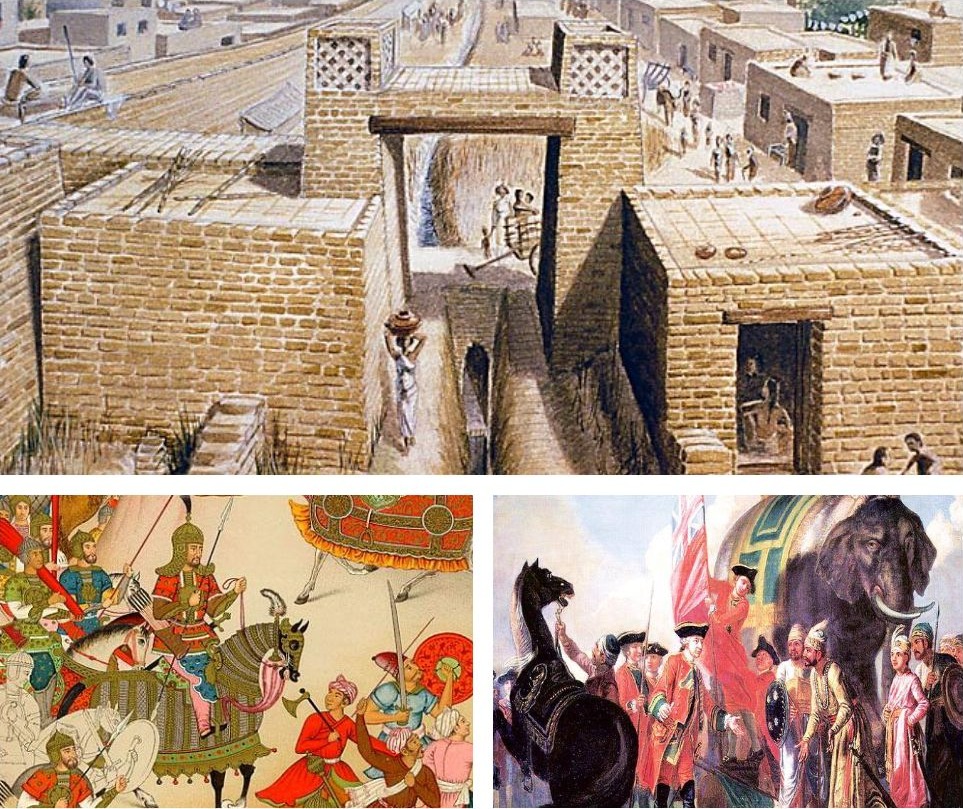
Indian history is as old as the history of mankind. It begins with the birth of the Indus Valley Civilization and the coming of Aryans.
- 2500 BCE Indian History began with the Indus River valley “Harappan” civilization.
- 327 BCE, Alexander the Great expanded across Central Asia, exposing India to Grecian influences.
- 3rd century BCE, under Ashoka the Great’s rule, the whole Indian sub-continent was politically under a single ruler for the first time.
- 4th and 5th centuries CE, northern India was unified under the Gupta Dynasty, the Golden Age of India.
- 8th century, Islam spread across the subcontinent over a period of 700 years.
- 17th century, Europeans came to India and the nation got colonized under the Dutch, Danish, French, Portuguese and finally the British rule.
INDIAN TRAVELOGUE



It’s the forts and palaces that grab your attention. Amber Fort & Palace, Hawa Mahal, City palace, Umaid Bhavan Palace are some of the palaces worth visiting (November to February)
Himachal Pradesh, is India’s outdoor adventure playground with spectacular snowy peaks and plunging river valleys. Along with trekking, climbing, crafting, paragliding and skiing Kullu-Manali, Shimla, Dharamsala, Dalhousie are some of the touristic places in Himachal (all the year).
Kerala, known as God’s own country, is South India’s most serenely beautiful state with beaches; a languid network of glistening backwaters; and the spice and tea-covered hills, elegant houseboats, ayurvedic treatments and delicately spiced, taste-bud-tingling cuisine. Kerala is home to wild elephants, exotic birds and the odd tiger, with vibrant traditions such as Kathakali plays, temple festivals and snake-boat rides. (September to March)
Kashmir, Branded as India’s Switzerland. It has alpine scenery and Srinagar’s romantic houseboat accommodation. Srinagar, Gulmarg, Leh, Jammu City are not to be missed in the months of March to October. To experience snowfall & snow games visit in the months of November, December & January.
Uttar Pradesh, UP is home to Varanasi famed for its cremation ghats and vibrant ceremonies along the Ganges River. In addition architectural and gastronomic masterpieces Toil Mahal, Agra Fort, Fatehpur Shikri, Agra Art Gallery, Mathura, Ayodhya, Vrindavan, Jhansi, Allahabad. (October to March)
Madhya Pradesh, Begun in the 10th century, its Hindu and Jain temples at Khajuraho are renowned for their carvings of erotic scenes, most prominently Kandariya Mahadeva, a temple with more than 800 sculptures. The eastern Bandhavgarh and Kanha National Parks are noted Bengal tiger sanctuaries. (October till March)
Odisha (formerly Orissa), is known for its tribal cultures and its many ancient Hindu temples. Bhubaneshwar, Cuttak, Puri, Rourkela, Konark are some must visit places in the State. Best time to visit Odisha is from Mid-October to End February.
CUISINES OF INDIA

Annapurna is derived from Sanskrit meaning the giver of food and nourishment. Anna means “food” or “grains” and purna means “full, complete and perfect”. Indian mothers and elderly women are termed as Annapoornas as they are the food givers in their families and societies.
Indian food and cuisine is an integral part of the Indian culture. There is extensive use of spices and herbs.
Each region has a different staple food depending on what grows there and also the climatic condition.
The curries, which are gravy-like sauce or stew are bases of major style of cooking especially for dishes with meat, vegetables, or cottage cheese, although the spice mixtures, degree of liquidity, and ingredients are determined by regional preference.
North India Cuisine:
Northern Indian cuisine reflects a strong Mughal influence. Some very popular dishes are Mutter Paneer, Daal Makhani, Dahi Gosht, Butter Chicken, Chicken Tikka, Amritsari Kulchas, Samosa Chaat, Motichoor Laddoo.
Southern Indian Cuisine:
South Indian cuisine is the hottest of all Indian food. Rice is a staple food and is combined with Sambaar and rasam, dry and curried vegetables and meat dishes. Idlis, Dosas, Vadas, Sambaar, Uttapams, Rasam, Payasam and a host of coconut-based chutneys and pappadums are some of the popular dishes in this cuisine.
Western Indian Cuisine:
Rajasthani food is spicy and largely vegetarian; popular dishes are: Daal Baati Churma, Panchmel Dal, Gujarat’s cuisine is known for its slight sweet touch. Thaali (a large plate) is a meal consists of variety vegetable dishes, farsans and sweets! In Maharashtra, coastal areas are famous for seafood and is rich, piquant and strongly flavored by coconut, red chilies, and vinegar.
Eastern Indian Cuisine:
Some popular dishes are Momos, Machcher Jhol (fish curry), and
Jhaal-Muri. Sweets are a big deal in East India. Favorites include Sandesh (made of paneer and sugar) and Roushgulla (dumplings
in syrup).
INDIA – A LAND OF RICH CULTURE AND HERITAGE
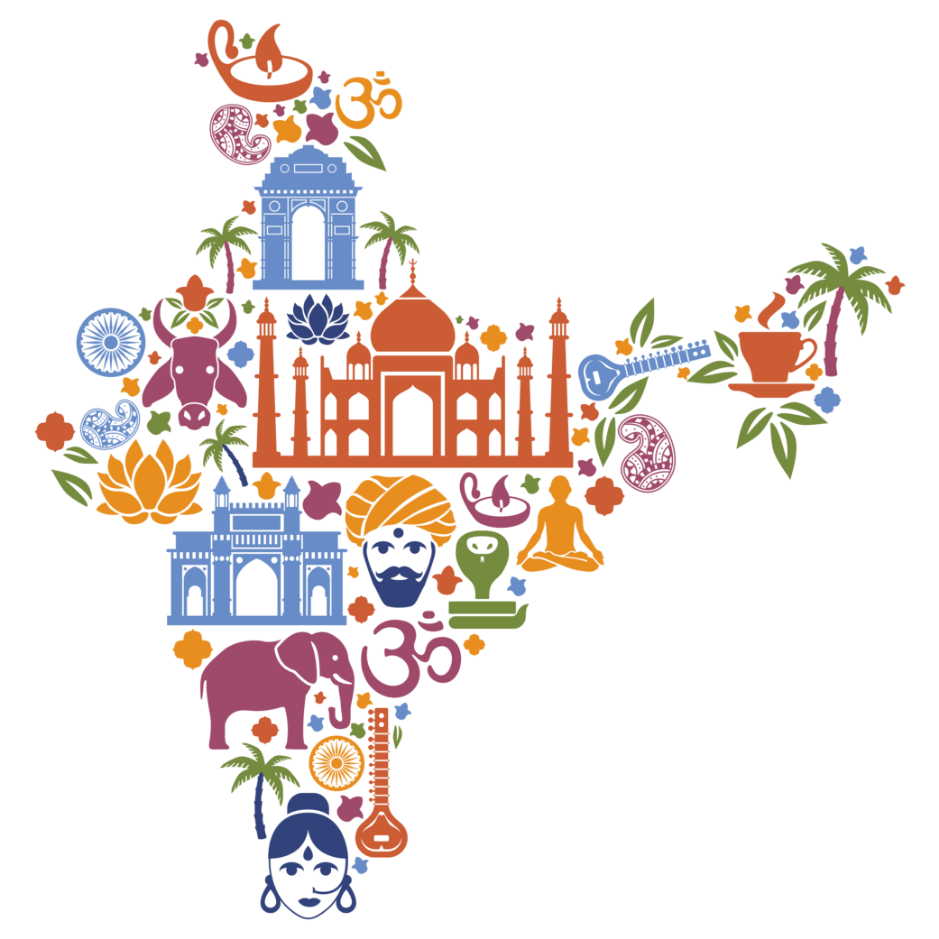
Indian culture is one of the most ancient cultures of the world dating back to more than 5,000 years old with the early Indus Valley Civilization. It is an amalgamation of several languages, religions, dance, music, architecture, food, dress patterns, movies and customs that differ from place to place within the country yet have a profound impact across the world.
There is a common saying about India “Unity in Diversity” which means India is a diverse country where people of many religions live together peacefully with their own separate cultures. Despite such diversity, Indian culture has the immense power to unite people together. The basic roots of our great culture are humanity and spiritual practices.
In addition to culture, India is also a land of values. Families (especially joint families) and schools play an important role in preserving and promoting the cultural and social values in a society, Sharing, caring and giving are important values of one’s dharma (religious duty) that are imbibed into Indians since childhood. Putting others before yourself is a large part of being an Indian because relationships are highly
valued here.
The ‘Namaste’ is one of the most popular Indian customs and isn’t just restricted to the Indian territory anymore. It literally translates to ‘Greetings to you’. In spiritual sense it means “The divine in me honors the divine in you”.
In India we believe in “Atithi Devo Bhava” (the guest is equivalent to God). We welcome and treat our guests like a God.
Indians being of tolerant and adaptable nature, can integrate a lot more into the local culture anywhere in the world, Indians, in addition to retaining their identify, also merge and fuse into the local culture with ease.
Religion: Hinduism is the largest religion, followed by Islam, Christianity, Sikhism, Buddhism, Jainism, & Zoroastrianism.
Language: There are approx. 1,652 different languages or dialects. Hindi being the national language while, English is used primarily in business and for political purposes.
FACTS YOU NEED TO KNOW
- India never invaded and country in her last 100,000 years of history.
- India is the fourth largest military powers in the world today.
- India has the largest number of Post Offices in the world.
- The largest employer in India is the Indian Railways, employing over a million people.
- Over 4,700 daily newspapers in more than 300 languages are published in India.
- India has the world’s largest movie industry, based in the city of Mumbai (known as the “City of Dreams”). The B in “Bollywood” comes from Bombay, the former name for Mumbai, Some of the other well-known regional film industries in India are: Tollywood (Andhra Pradesh), Mollywood (Kerala) & Kollywood (Tamil Nadu)
- While most countries in the world have one national language, India has a different language for each of its 29 states. An average Indian can speak minimum 2 languages at any given point in time.
INDIA’S CONTRIBUTIONS TO THE WORLD
- Acharya Charaka consolidated Ayurveda – an ancient and traditional system of medicine, 2500 years ago, that dates to Iron Age India (1st millennium BC) and is still practiced.
- Yoga was originated in India about 5,000 years ago.
- Sushruta regarded as the ‘Father of Surgery’ conducted many surgeries such as cataract, cesarean, and fractures in the sixth century BCE.
- The concepts of Algebra, Trigonometry, Geometry and Calculus originated from India that traces back to 1200 BCE.
- The concept of Pi was first discovered by Budhayana in 800 BC. He also devised the concept of Pythagorean theorem.
- The earliest cotton in the world was spun and woven in India. Roman emperors called it, “woven winds.” Mogul emperors called the fabrics “morning dew” and “cloth of running water.
- Chess was invented in India in 6th Century AD.
- Diamonds were first mined in India 5,000 years ago and was the only source in the 18th century.
- India invented the Number System, Zero (0) was invented by Aryabhatta.
THE FABRICS OF INDIA
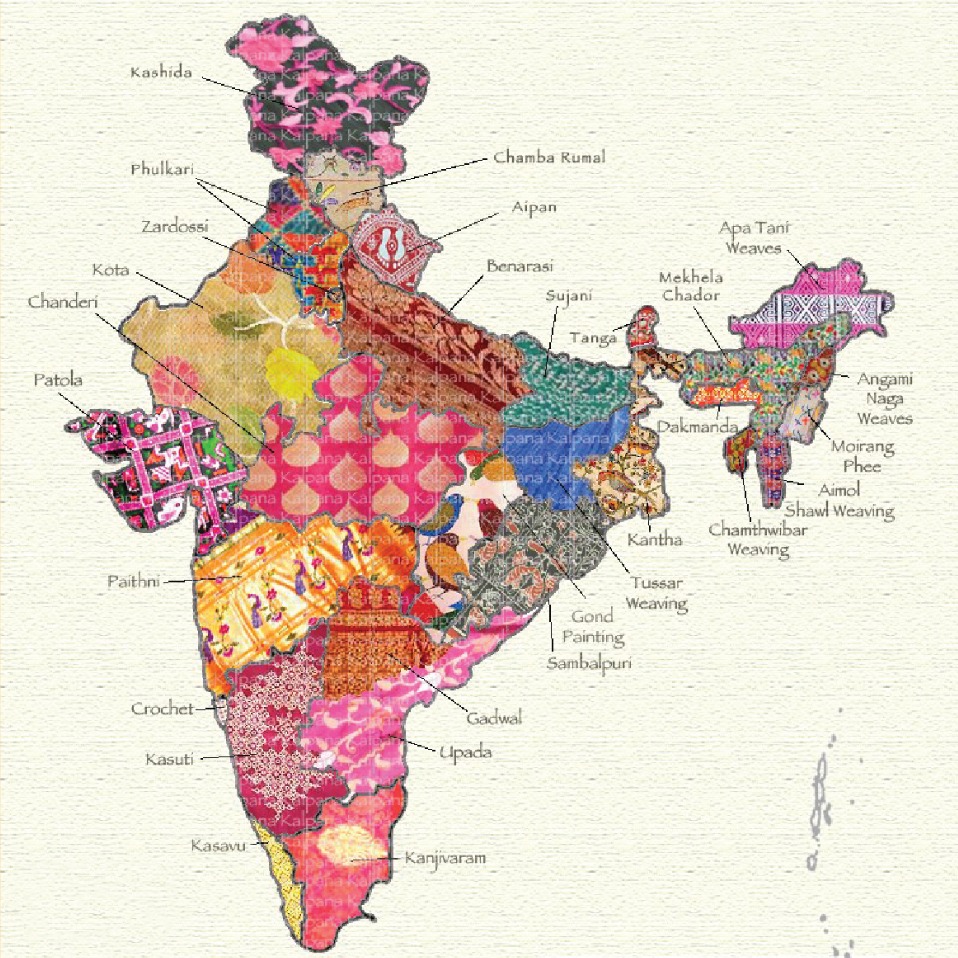
Indian cotton threads date to around 4000 BC and dyed fabrics to 2500 BC. The varied geographical regions and climate provide a huge range of plant fibres and natural dyes for the cultivators, weavers, dyers, printers and embroiderers of the subcontinent.
Cotton and silk are the raw materials most associated with Indian textiles. India’s wild and semi-domesticated silks continue to provide a huge range of yarn and fabric for local use. Other animal fibres used to make textiles include sheep’s wool and yak-and goat-hair.
From Kashmir to Kanyakumari, every region has its own handloom techniques that are used to weave many unique fabrics. Such as; Kalamkari from Andhra Pradesh; Muga Silk from Assam; Bhagalpuri Silk from Bihar; Bandhani from Gujarat; Mysore Silk from Karnataka;
Chanderi from Madhya Pradesh; Paithani from Maharashtra; Phulkari from Punjab; Kanjeevaram Silk from Tamil Nadu; Ikat from Telangana; Chikankari from Uttar Pradesh, etc.
The skills and activities are kept alive by passing them from generation to generation. Indian weavers blend myths, faiths, symbols and imagination to bring an appealing dynamism to the fabric. It is the distinct form of art, weave and color usage of the artisan that give every region its distinctive identity and uniqueness.
DANCE
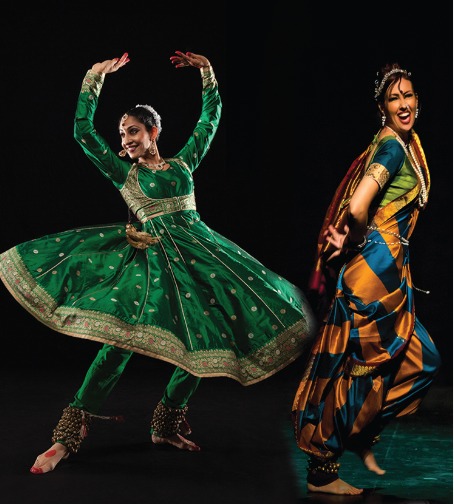
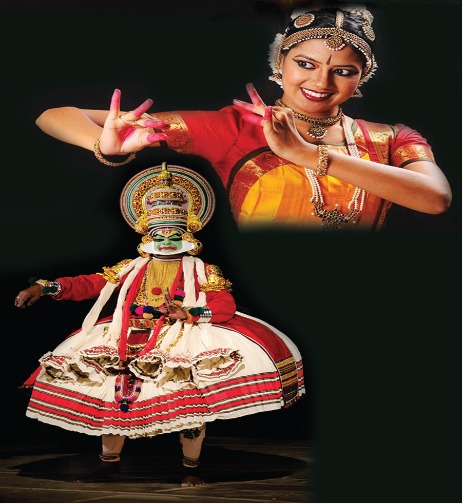
- Bharatanatyam, from Tamil Nadu
- Kathak, from Northern and Western India
- Kathakali, from Kerala
- Kuchipudi, from Andhra Pradesh and Telangana
- Odissi, from Odisha
- Sattriya, from Assam
- Manipuri, from Manipur
- Mohiniyattam, from Kerala
- Chhau, from Jharkhan, West Bengal and Odisha
- Oyilattam, from Tamil Nadu.
MUSIC
Hindustani music: The tradition of Hindustani music dates to the Vedic times. It diverged from Carnatic music around the 13th-14th century CE, primarily due to Islamic and Persian influences practiced by Moughuls. Classical genres are dhrupad, dhamar, khyal, tarana and sadra etc.
Carnatic music: was originated in South India during the rule of Vijayanagar Empire. It consists of a composition in the forms of Raga Alapana, Kalpanaswaram, Neraval. Around 300 ragams are in use today.
SCULPTURES
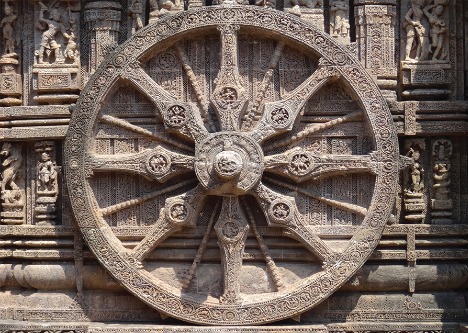


- The Indian monumental sculpture in stone began with the reign of Ashoka, and the Pillars of Ashoka he erected around India. The Great Stupa of Sanchi was initially commissioned by the Mauryan king Ashoka in the 3rd century BCE. It is in Sanchi in the Raisen district of Madhya Pradesh. The complex flourished until the 11th century BCE and is now a major tourist attraction.
- The Ajanta Caves are a group of around 30 rock-cut Buddhist caves in the shape of a horseshoe in the Aurangabad district of Maharashtra. Build in the 2nd century BCE they include cave paintings and rock-cut sculptures inspired by the art that was prevalent in India. Many caves depict the stories of the past lives and rebirths of the Buddha. They are under the care of the Archaeological Survey of India and a UNESCO World Heritage Site.
- The Kailasa Temple, a part of the Ellora Caves in Aurangabad district of Maharashtra, India, is one of the biggest rock-cut structures in India. It is a gigantic megalith, having been carved out of just one single rock. It is considered a remarkable feat because of its architecture, sculptural treatment and the sheer size.
MONUMENTS
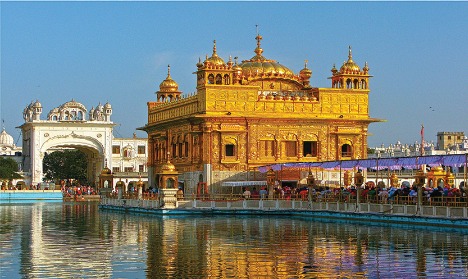
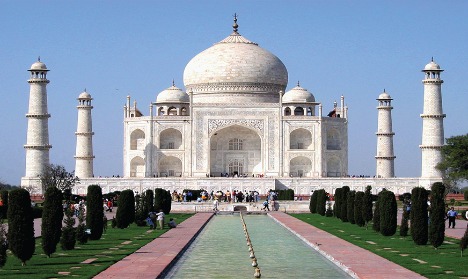
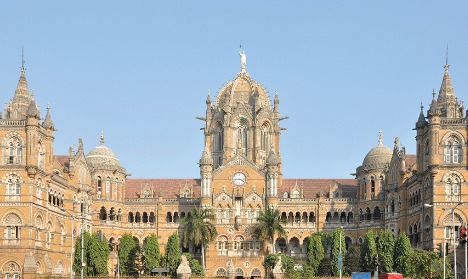
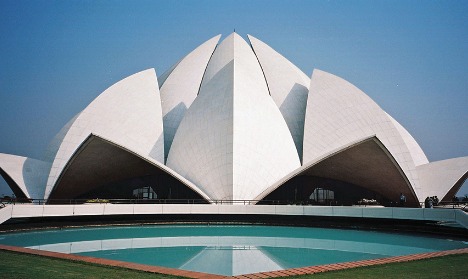
- Taj Mahal:A beautiful white marble monument located in the city of Agra on the banks of the holy river Yamuna in the state of Uttar Pradesh. It is one of the eight wonders of the world.
- Mysore Palace:The Palace of Mysore is located in the city of Mysore in Karnataka and one of the most visited monuments in India.
- Golden Temple: The Golden Temple located in the Amritsar, Punjab is the holiest shrine and most famous pilgrimage place for Sikhs.
- Lotus Temple: The Lotus Temple of Delhi is a house of Worship for every religion and best place for meditation and peace.
- Chhatrapati Shivaji Terminus: Or Victoria Terminus is a historic railway station situated in the dream city of India Mumbai, Maharashtra.
- Qutub Minar: This monument in Delhi one of the tallest and famous towers in the world and second tallest Minar in India.
FESTIVALS

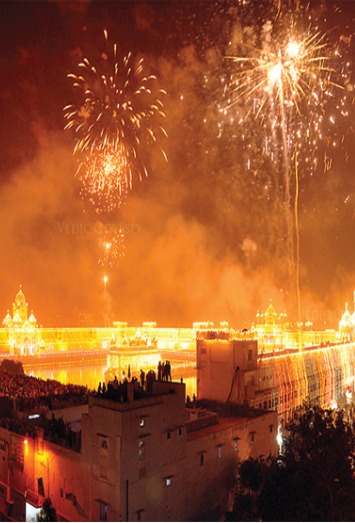
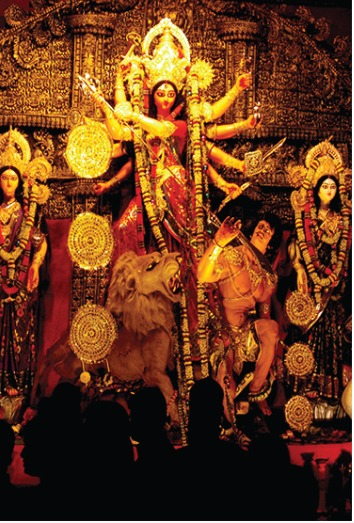
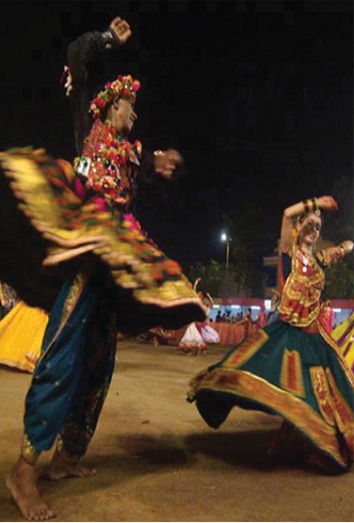
The spirit of India is expressed year-round in festivals as diverse as the country’s landscape. Indian festivals have a great social, religious and mythological value. People forget all their differences and observe these festivals with a sense of togetherness and universal brotherhood.
Makar Sankranti (January)
Makar Sankranti is observed with social festivities such as colourful decorations, rural children going house to house, singing and asking for treats in some areas, melas (fairs), dances, kite flying, bonfires and feasts. The Magha Mela is mentioned in the Hindu epic Mahabharata.
Holi (March)
The most popular known as the ‘festival of colors’, Holi celebrates the victory of good over evil and the arrival of spring. On this day, people
gather and apply dry and wet colors to each other in a beautiful, rainbow mess.
Gudi Padwa (April)
On the festive day, courtyards in village houses will be swept clean and plastered with fresh cow-dung. Even in the city, people take the time out to do some spring cleaning. Women and children work on intricate rangoli designs on their doorsteps, the vibrant colours mirroring the burst of colour associated with spring. Everyone dresses up in new clothes and it is a time for family gatherings.
Raksha Bandhan (August/September)
Raksha Bandhan is observed on the last day of the Hindu lunar calendar month of Shraavana, which typically falls in August. The expression “Raksha Bandhan” (Sanskrit, literally “the bond of protection, obligation, or care”) is now principally applied to this ritual. Until the mid-20th century, the expression was more commonly applied to a similar ritual, held on the same day, with precedence in ancient Hindu texts.
Ganesh Chaturthi (August/September)
The most loved, beloved Lord Ganesha, the elephant-headed God is worshipped for 10 days. Idols of the lord are decorated and worshipped in most houses and on the tenth day, the idol is immersed in water, believing HE goes back to HIS parents to come back again next year.
Onam (August/September)
For Onam, people wear traditional clothing and decorate their houses with floral designs. The festival celebrates the homecoming of legendary King Mahabali. The spectacular Snake Boat Race is one of the festival’s highlights, enjoyed by locals and tourists alike in the state of Kerala.
Navratri (September/October)
Longest Hindu festival, lasting nine consecutive nights. For the first nine days goddess Durga is honoured while the tenth day pays tribute to the spiritual hero Lord Rama (of the epic Ramayana).Garba and Dandiya are performed all nights to celebrate this.
Diwali (Mid-October/Mid-November)
A five-day festival celebrated throughout India, representing the start of the Hindu New Year. The widespread glow of diyas (clay lamps) gives the festival its nickname, the “Festival of Lights.” The country is lit up during these days. Celebrations with family is a major thing during Diwali.

